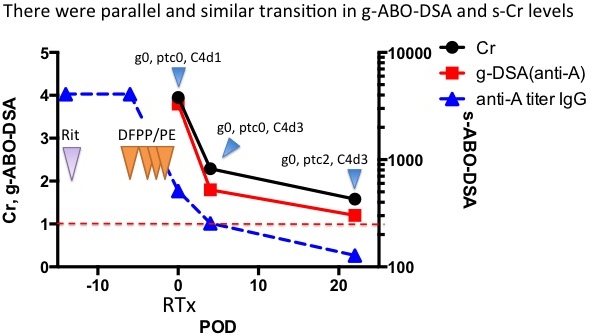Graft Immunocomplex Capture Fluorescence Analysis Can Detect Intra-Graft Anti-Blood Group A/B Antibodies
1Department of Organ Transplantation and General Surgery, Kyoto Prefectural University of Medicine, Kyoto, Japan
2Department of Blood Transfusion and Cell Therapy, Kyoto Prefectural University of Medicine, Kyoto, Japan
3Molecular Diagnostics Division, Wakunaga Pharmaceutical Co., Led, Hiroshima, Japan.
Meeting: 2018 American Transplant Congress
Abstract number: D15
Keywords: Antibodies, Graft survival
Session Information
Session Name: Poster Session D: B-cell / Antibody
Session Type: Poster Session
Date: Tuesday, June 5, 2018
Session Time: 6:00pm-7:00pm
 Presentation Time: 6:00pm-7:00pm
Presentation Time: 6:00pm-7:00pm
Location: Hall 4EF
Background: Graft immunocomplex capture fluorescence analysis (ICFA) is an attractive method to detect intra-graft donor-specific anti-HLA antibodies (HLA-DSA). In ABO incompatible (ABOi) transplantation, anti-A/B antibodies are also considered as important DSA (ABO-DSA). Thereupon, it is also useful to monitor intra-graft ABO-DSA to assess AMR by applying the ICFA technique.
Methods: To capture A/B antigens, anti-Band III, VW, and PLVAP beads were composed. The allograft specimen was dissolved in PBS by the lysis buffer. Anti A/B antibodies were added for a positive control sample. Subsequently, A/B antigens were captured by anti-Band III, VW, or PLVAP beads. Then, the immune complexes were detected by anti-human IgG antibodies (PE), analyzed by a Luminex system.
Results: Although Band III and VW beads indicated false-positive/negative, PLVAP beads were capable to capture A/B antigens with high sensitivity and specificity (>95%) provided that a ratio (sample/blank beads MFI) >1.0 was considered as positive. By immunohistological examination, the proximity in A/B antigens and PLVAP expression was confirmed. Report of a case: Consecutive four biopsies following an ABOi renal transplant recipient (A to O)were analyzed. With desensitization by rituximab and DFPP, the post-transplantation course was uneventful. Graft ICFA showed as follows: 3.2 (1h, s-Cr 4.0 mg/dl titer IgG/M:512/8, g0, ptc0, C4d1); 1.8 (4 days, s-Cr 2.3, titer 256/16, g0, ptc0, C4d3); 1.2 (22 days, s-Cr 1.6, titer 128/8, g0, ptc2, C4d3). This result indicated that the remnant ABO-DSA were adsorbed, and subsequently removed from the allograft successfully. 
Conclusions: This application would detect intra-graft ABO-DSA, which could lead to a correct diagnosis and shed light on the ABO-DSA kinetics following ABOi transplantation.
CITATION INFORMATION: Nakamura T., Ushigome H., Imanishi Y., Kawai S., Shirouzu T., Osaka M., Masuda K., Matsuyama T., Harada S., Nobori S., Yoshimura N. Graft Immunocomplex Capture Fluorescence Analysis Can Detect Intra-Graft Anti-Blood Group A/B Antibodies Am J Transplant. 2017;17 (suppl 3).
To cite this abstract in AMA style:
Nakamura T, Ushigome H, Imanishi Y, Kawai S, Shirouzu T, Osaka M, Masuda K, Matsuyama T, Harada S, Nobori S, Yoshimura N. Graft Immunocomplex Capture Fluorescence Analysis Can Detect Intra-Graft Anti-Blood Group A/B Antibodies [abstract]. https://atcmeetingabstracts.com/abstract/graft-immunocomplex-capture-fluorescence-analysis-can-detect-intra-graft-anti-blood-group-a-b-antibodies/. Accessed January 2, 2026.« Back to 2018 American Transplant Congress
